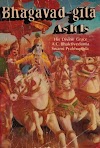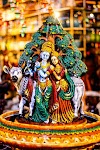The glory of Gita is indescribable.
It has many rare doctrines which are so helpful for the people living in
today's era that all the hardships of life will become easy to bear with and
humans will come to know the real meaning of life. The language of Bhagavad
Gita is Sanskrit which is simple to understand after a little practice but each
and every shloka of every chapter of Bhagavad Gita is so deep and full of
meaning which will enlighten the human soul forever. Every time after reading
Bhagavad Gita you will understand a new meaning, a fresh insight and a new
dimension of truth being revealed to you .If one reads Bhagavad Gita with the single directed and concentrated mind
full of Faith, belief and reverence then every shloka of Bhagavad Gita will
appear as mysterious knowledge, as precious as a Kohinoor gem and a priceless
possession at the same time. Bhagavad Gita is believed to have been spoken by
Supreme personality of godhead himself Lord Krishna (avatar of Lord Shri Vishnu
) in the battle ground of Kurukshetra to his favourite devotee Arjuna such that
each and every Shloka each and every word is full of some spiritual import. Sri
Veda Vyasa after describing Gita in his book Mahabharat sad in the end –
 |
| Chariot of Arjuna driven by lord Krishna in Battleground of Kurukshetra |
Sri Ved Vyasa After describing Gita in his book mahabharata Said in the end-The Gita should be
carefully studied, that is after reading the text its meaning should be
gathered and held in the mind. It emanated from the Lotus like lips of Bhagwan
Vishnu himself( in his krishn avtar) . Moreover the lord himself also describe
its Glory at the end of Gita chapter 18 verses 68 to 71(will discuss
later in Chapter 18)
Man irrespective of any
caste, creed, race or sex possess the right to study the Bhagavad Gita. The only
qualifications needed by one are faith and reverence as it is God’s will to
propagate the Gita only among his devotees and through worship of him by the
performance of their own nature bound duties man can attain perfection. In chapter
18 verse 46 ( to be discussed later) if one reflect on this verse it makes
clear that everybody has equal right to God realisation
In 21st century many
people who lack understanding of truth behind the subject make assertion that
the book is intended only for monks and ascetics and they are reluctant to make
this book a part of their children life, out of fear that after reading it,
they may renounce their homes and family and turn ascetic themselves but one
should not forget that Arjuna who was soft hearted and a believer of Karma and
follower of Dharma was prepared to run away from battle ground of Kurukshetra
after seeing his brother and elders on other side of Army He was ready to live
on alms , being influenced by the most secret and mysterious teaching Gita and
completed a life of a householder all his life on earth and performed his duty
which is itself a proof that Gita cannot produce some 180 degree opposite
result. Modern human beings must also read Gita for their own welfare and come
out of delusion and with utmost faith and reverence must induce their children
to study the real meaning of Bhagavad Gita and understand the meaning and
underlying truth of each and every word and simultaneously reflect on
themselves and take to spiritual practice. Human beings are the most advanced
species on earth and for having taken birth as a human it is very improper for
one to waste even a single minute of his time in indulgence in temporary and
transient enjoyment which are the main root of sorrow and sadness of human
life.
·
Gita is a source of
inspiration for all living beings
·
while reading the book
each and every individual will make their own interpretation from each one of
the verses mentioned in the book as per their thought process, belief, thinking
and every time after reading, a new thought will definitely come up in the mind,
such is the depth of knowledge which is hidden in this book.
·
Gita is a beacon of
light to guide the humanity to live a better life on how to make environment
around us better and leave a legacy for future generations to have an exemplary
living condition.
SETTING OF BHAGAVAD GITA
The Mahabharata which is
one of the two great Hindu epics( the other one is Ramayana) and the one in
which Bhagavad Gita appears at the climactic moment when Lord Sri Krishna who
is driving the chariot of the great Warrior Arjuna is dejected and distressed
and was in doubt about his duties before
the beginning of famous battle of Kurukshetra to establish dharma and righteousness
in society. The heroes of the battle known as Pandava princes are Arjuna
and his half-brother Yudhisthira, Bheema
Nakul and sahadeva. The villains are the hundred sons of Dhritarashtra, also known as Kaurvas princes (sons Of Kuru). This battle is itself
is a tragic episode in which nearly all the Kshatriya or Warrior race is
destroyed , villains being killed and the heroes who are not slain, die on a
long pilgrimage eventually attending heaven with the exception of king Yudhisthira
who reaches Heaven by another roundabout route. Bhagavad Gita is a Jewel in
Mahabharat which took place as a dialogue between Lord Sri Krishna and his
friend the Pandava Prince Arjuna ,the dialogue is about life, living
relationships, duties, habits and many more. The Bhagavad Gita is in the
Mahabharata after the first 5 chapters and there are 9 chapters after it.
Bhagavad Gita itself consists of 18 chapters and 700 slokas as mentioned
below
Chapter 1: The Yoga of
Arjuna’s Dejection (arjuna-viṣāda-yoga)
Chapter 2: The Yoga of
Analysis (sāṅkhya-yoga)
Chapter 3: The Yoga of
Action (karma-yoga)
Chapter 4: The Yoga of
Knowledge (jñāna-yoga)
Chapter 5: The Yoga of
Renunciation (sannyāsa-yoga)
Chapter 6: The Yoga of
Meditation (dhyana-yoga)
Chapter 7: The Yoga of
Wisdom (vijnana-yoga)
Chapter 8: The Yoga of
Liberating Spirit (tāraka-brahma-yoga)
Chapter 9: The Yoga of
Royal and Hidden Knowledge (rāja-vidyā-rāja-guhyayoga)
Chapter 10: The Yoga of
Excellence (vibhūti-yoga)
Chapter 11: The Yoga of
Seeing the Cosmic Form (viśva-rūpa-darśana-yoga)
Chapter 12: The Yoga of
Devotion (bhakti-yoga)
Chapter 13: The Yoga of
Distinguishing Matter from Spirit (prakṛti-puruṣaviveka-
yoga)
Chapter 14: The Yoga of
the Threefold Modalities (guṇa-traya-vibhāga-yoga)
Chapter 15: The Yoga of
the Ultimate Person (puruṣottama-yoga)
Chapter 16: The Yoga of
Differentiating Godly and Ungodly Assets (daivāsurasampad-
vibhāga-yoga)
Chapter 17: The Yoga of
Differentiating Threefold Faith (śraddhā-traya-vibhāgayoga)
Chapter 18: The Yoga of
Liberation (mokṣa-yoga)
I request that you take advantage of this book and enter into its understanding I also request that you make an appointment to meet your God now through the self liberating process of yoga (Union) and give peace a chance-George Harrison, member of the famous Beatles group
DIVISION OF BHAGAVAD GITA
The
Bhagavad Gita is divided into 3 parts
- Chapter
1 to 6 (Karma Yoga)
- Chapter
7 to 12 (Bhakti yoga)
- Chapter
13 to 18 (Jnana yoga)
Bhakti yoga is kept in
the middle of Shrimad Bhagavad Gita because Bhakti is considered as a very
secret, it is mentioned in Bhagavad Gita 15.15 as a sense of all scriptures
without Bhakti karma and gyan yoga are dead therefore Bhakti give life to both
karmayog and Jnana yoga and it is placed in center. Generally it is not
considered right to disclose secret until we become intimate accustomed and we
acknowledge the Supremacy of Lord out of respect. For example in old times
whenever King used to travel with his army men to some other on nearby area or
Kingdom, king was always placed in the center being led and followed by a
cavalry and foot soldiers. In the same
way Bhakti Yoga is protected here by Chapters on karma yoga and Jnana Yoga.
That’s all for this post. Keep Chanting Hare Krsna and if you would like to read more do check following links
- Welcome
to the journey of Bhagvad Gita, Hare Krsna!!
- All
about Ekadashi - The Holy Day
- Gita
Mahatmya (Glories) by Shri Adi Shankaracharya and Kamika Ekadashi
- Sacred
Invocations
- Krishna
Janamashtmi
- 125th
Birth Anniversary of Srila Prabhupada Ji - Founder of ISKCON










1 Comments
Videos for YouTube - vimeo - Vimeo - Videodl.cc
ReplyDeletevimeo.com videos are the internet's most popular source of high quality content. View high quality vids and explore youtube converter our videos for free!